Villar-Perosa Submachine Gun Family (Italy)
A hundred years ago, gunsmiths did not have modern knowledge and experience, which led to interesting results. So, the Villar-Perosa family of weapons was initially positioned as a machine gun, but had to use a pistol cartridge. Thus, according to the modern classification, this weapon belongs to the class of submachine guns. At the same time, however, a number of characteristic features proposed by the authors of the project implied the use of weapons “in machine-gun mode”. As a result, the original submachine gun, so to speak, was more of a machine gun than a pistol.
The Villar-Perosa project was launched in 1914 year. Shortly after the start of the fighting in Europe, the Italian officer Bethel Revelli, who already had experience in developing small arms, proposed the original design of weapons for aircraft. As planned by the officer, the airplanes of the Italian army should be armed with movable turrets with new machine guns to develop it. To simplify the design and enhance performance, a system was proposed consisting of two independent blocks with their own automation units and using a pistol cartridge. Soon after the design was completed, the new weapon was presented to the military.
Proposed aviation a machine gun turret was of certain interest, but still did not suit the military. The main complaint against him was the relatively weak pistol cartridge 9x19 mm Glisenti. Such ammunition had a relatively light bullet, and also provided an initial speed of no more than 300-320 m / s. As a result, the effective range of fire and the power of bullets left much to be desired and did not allow to count on the full defeat of enemy aircraft or balloons. Thus, the machine gun design B. Revelli was not suitable for installation on airplanes. In the future, Italian aviation received other weapons with higher characteristics.
The capabilities of the new machine gun were not suitable for aviation, but it could be used in the ground forces. In 1915, a new version of weapons appeared, adapted for use in the army. This modification of the machine gun was called Villar-Perosa M1915 and quickly enough was able to reach mass production. The main features of land battles allowed not to pay attention to a number of machine gun features that had previously prevented its use in aviation.
One of the main objectives of the original project was to achieve the highest possible rate of fire, due to which it was planned to provide acceptable combat performance. Not wanting to use new, unfinished ideas and solutions, B. Revelli proposed the implementation of a new machine gun in the form of two aggregates connected to each other with their own automation on each. Such a design was supposed to be a reasonable compromise between complexity and high performance.
The base of the Villar-Perosa M1915 machine gun was two basic blocks, each of which was an independent submachine gun chambered for “Glizenti”. This weapon had a receiver in the form of a circular tube with several slots and windows. In the front end of the tube was placed the sleeve of the trunk, behind it there were windows for the store (top) and for the ejection of the sleeves (bottom). On the right surface of the box was provided a groove of complex shape for the shutter handle. In front of it there was a bend, the remaining sections were straight. Below the back of the tube there was a slot for the elements of the firing mechanism. Finally, the open rear end of the box was closed with a lid integrated with the handles.
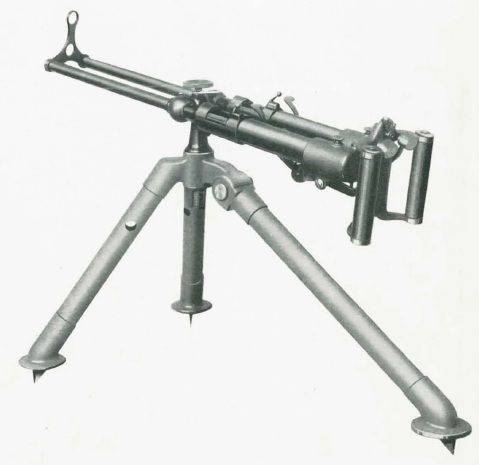
Machine gun on a tripod. Photo Forgottenweapons.com
Inside the receiver there was a massive cylindrical gate with a drummer and liner extraction means. On the side of the gate was attached loader handle. In the extreme forward position, the bolt was held by means of a reciprocating spring, which occupied the entire rear part of the receiver.
The power supply of such a unit was to be carried out using detachable box magazines placed in the upper window of the receiver. With the help of the spring, the cartridges were supposed to be supplied to the rolling gate, after which he independently sent them to the chamber. Ejection of spent cartridges was made automatically through a window at the bottom of the receiver.
The Villar-Perosa M1915 product had an automatic based on a semi-free shutter, and the aggregates of the two “halves” of the weapon were in no way connected to each other. Under the influence of the reciprocating spring, the bolt from the rearmost position had to move to the front, taking the cartridge from the store and sending it to the chamber. In the extreme forward position, a shot was fired, after which the shutter began to move in the opposite direction. At the initial stage of movement back, the bolt was inhibited due to the interaction of the handle and its groove in the receiver. The front inclined part of the groove made the bolt rotate and thereby reduced its speed. The final braking was done by a spring. In the rearmost position, the shutter was fixed by the sear entering through the slot in the bottom of the box.
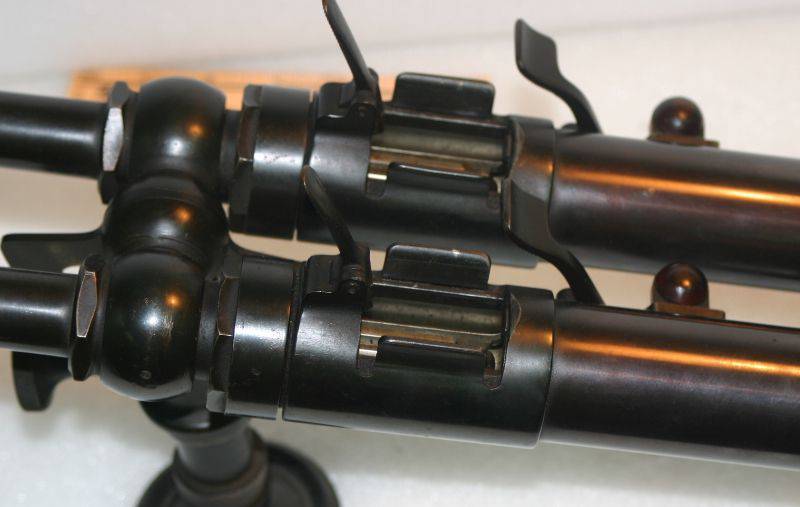
The upper part of the receiver boxes and receiving windows stores. Photo Forgottenweapons.com
Increasing the rate of fire was achieved not only through the use of a paired design, but also by using the correct balance between the mass of the bolt and the stiffness of the return-combat spring. Due to the light shutter and stiff spring, the “half” of the machine gun could fire at a rate of up to 1500 rounds per minute. The overall rate of fire of the entire system, respectively, reached 3 thousand shots per minute.
In the M1915 modification, two basic units were combined into a single structure using a pair of main parts. A massive metal washer with two openings was worn on the trunks, and a complex-shaped part was attached to the rear parts of the receiver. In the front part there were two cylinders that served as the covers of the receiver boxes, and the rear was made in the form of two vertical arms, similar to those used on machine guns of the time. On this detail were fastened two L-shaped swing arm, responsible for controlling the fire. The upper end of the lever was made in the form of a button-trigger, and the lower one was used as a sear and had to hold the bolt in the rear position. When pressing the trigger, the sear was retracted downwards and released the bolt. Two levers with buttons had to interact with two basic units, which made it possible to fire both from two barrels and alternately from one or the other.
Between the jacks there was a fuse in the form of a T-shaped part. In the on state, the fuse did not allow the jacks to move and thus blocked the descent. When rotated at an angle of about 90 °, the lower arm of the fuse allowed the arms to swing normally and shoot.
For greater convenience of working with weapons when connecting two separate units, a device was installed on them for simultaneous reloading. It consisted of two curved arms connected by a common axis. The axis was located on the bottom of the receiver boxes. When turning one of the levers, both arms were moved backward, which led to the simultaneous cocking of both mechanisms. If necessary, the valves could be cocked separately, using only their own handles.
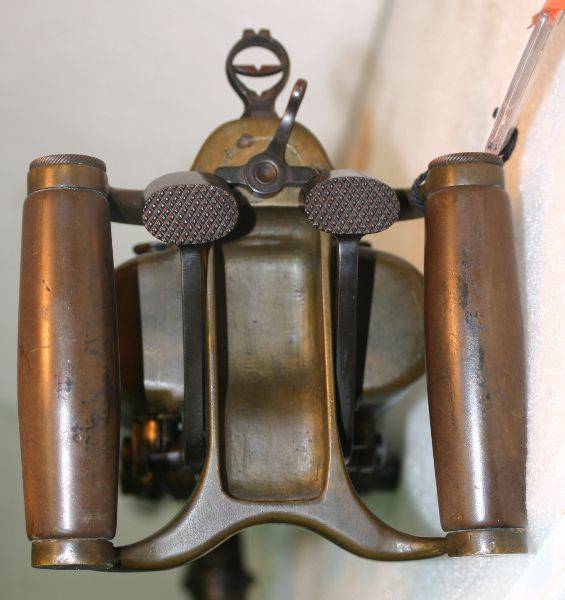
Handles and triggers. Photo Forgottenweapons.com
The sights of the Villae-Perosa M1915 machine gun consisted of a front sight and a rear sight. The fly was mounted on the part connecting the two barrels, and the rear sight was located on the rear unit with the fire control knobs. Depending on the particular features of the execution of weapons, the design of sights could change. However, in all versions of the double-barreled submachine gun had only one set of sighting devices.
The machine gun for the infantry was not too heavy - about 6,5 kg without additional equipment. Nevertheless, it was originally proposed to use it only in a set with special machines. A light metal tripod was developed, which allowed the weapon to be placed on the ground or another support, and a special wooden frame-pan for the tripod was offered. In front of the receiver of weapons could be mounted an additional armored car with a window for aiming.
Over time, the production of wooden rifle-type lodges with a butt was mastered. This product was attached to the body of the machine gun without any of its modifications and, as suggested, allowed to fire not only from the stop, but also on the go. Nevertheless, the proposed "manual" version of the machine gun had a characteristic drawback in the form of ambiguous ergonomics. For simultaneous firing from two barrels, it was necessary to hold the weapon by the handles with both hands and at the same time press the release buttons.
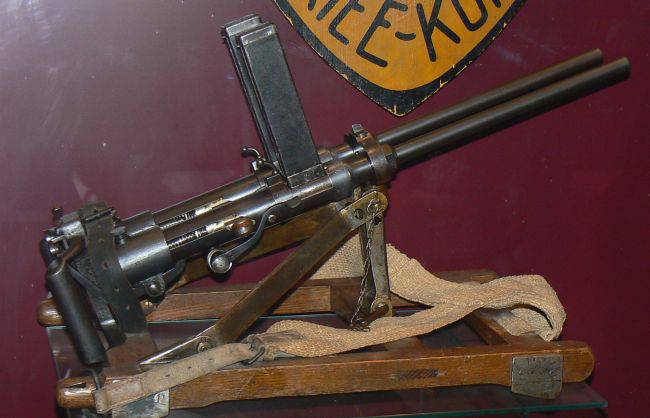
Machine gun M1915 on the machine with a pallet. Photo Wolrd.guns.ru
The submachine gun Villar-Perosa M1915 was approved by the military and already in the 1915 year went into the series. The small mass of weapons with relatively high fire characteristics interested the command of some army structures. As a result, the vast majority of new machine guns were sent to the mountain-rifle and assault units, which required light, simple, but effective weapons.
The new weapon allowed Italian soldiers to effectively attack and hit the enemy at distances of up to several hundred meters (with the stated target range of fire was 1800 m), literally watering him with bullets. A high rate of fire, at the level of 3000 rounds per minute, was useful in a number of situations, but often led to increased ammunition consumption. Because of this, over time, a method of using weapons was developed, which was later used by all machine gunners. Two basic units with their own mechanisms and trunks should be used alternately. This allowed halving the consumption of ammunition without an unacceptable reduction in firepower, and also contributed to firing with minimal interruptions. Having devastated one magazine, the shooter could shoot from the second unit. At the same time, the second calculation number could change the empty magazine, which allowed the first barrel to be used again after the cartridges were used up in the second store.
In various modifications, differing in additional equipment, machine guns Villar-Perosa M1915 were actively used by the Italian army until the very end of the First World War. This weapon has proven itself well in battles, as it had notable advantages over other small arms.
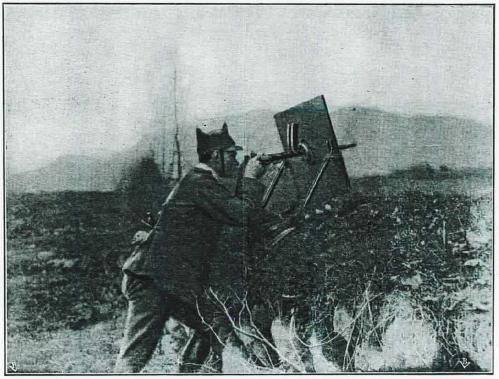
The shooter uses a machine gun on a tripod with a flap. Photo Forgottenweapons.com
Despite all the positive qualities, the B. Revelli submachine gun had a number of specific flaws that negatively affected its practical operation. The main one was excessive rate of fire. In the case of aircraft armament, the possibility of shooting at a rate of up to 3 thousandths of shots per minute was justified, but for the infantry it was redundant and disadvantageous in terms of ammunition consumption and the weight of the necessary ammunition. In addition, the architecture of weapons with two independent base units, which increased the rate of fire to meaningless values and led to a noticeable increase in the weight of the whole structure, was also considered inexpedient.
It was decided to recycle the existing machine gun and create on its base a full-fledged small arms for infantry, suitable for carrying and more convenient use. This modification was called Villar-Perosa OVP M1918. The basis for the new weapon was taken from one of the basic units of the machine gun, which lost some of the parts and got some new ones. For example, the sights were moved from individual parts to the barrel and receiver, and the back cover of the box was replaced with a new one. Also, the bolt and return spring were modified. The purpose of such improvements was to reduce the rate of fire to an acceptable level.
The existing unit, which contained elements of the firing mechanism, was to be attached to the existing cylindrical receiver. This product was a metal cylindrical housing, worn on the back of the existing receiver. Inside were several parts, including the sear, the fuse, and the mechanisms of the two triggers. To simplify the design of the trigger for single and automatic fire had to meet different hooks. A wooden rifle butt with a pistol protrusion was attached to the back of the new product.
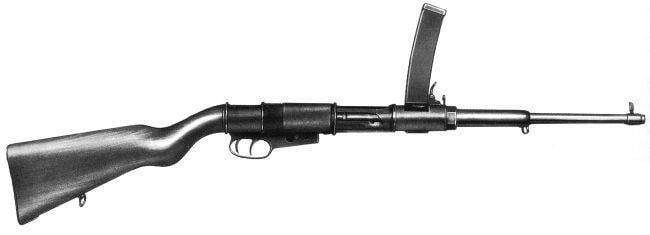
General view of the submachine gun Villar-Perosa OVP M1918. Photo of Wikimedia Commons
Similar processing of a design allowed to reduce the weight of the weapon sharply. The body of a double-barreled machine gun M1915 without additional equipment weighed about 6,5 kg, while the mass of OVP M1918 (without cartridges) was only 3,6 kg. Thanks to the new bolt and spring, the rate of fire did not exceed 900 shots per minute, which ensured an acceptable ratio of firepower and ammunition consumption.
Upgraded submachine guns Villar-Perosa OVP M1918 were made from scratch, and also made by reworking the existing M1915. The rearmament of the army began at the end of the tenths, shortly after the appearance of the new design. Single-barrel submachine guns of the new model were one of the main types of weapons in Italy for two decades, until the beginning of World War II. Over time, this weapon was partially superseded by newer models, but still continued to be actively used by the army.
According to some sources, Italy planned to sell the Villar-Perosa M1915 machine guns to third countries. Approximately in 1915-17 the modification of this weapon was created for the .455 Webley cartridge, which was proposed by the UK. A number of such machine guns were transferred to the British military for testing. Weapon checks did not lead to the conclusion of a contract, and one of the machine guns sent later became a museum exhibit.
During the First World War, weapons designs that are now considered classical either either did not exist or were only developed. As a result, a large number of samples of the original look and architecture appeared, which could hardly be developed now. Nevertheless, many of these strange systems came into mass production and were used by the armies of different countries. One example of this was the Villar-Perosa M1915 machine gun. In addition, this weapon has become a curious example of how not the most successful design eventually turns into a full-fledged weapon with good characteristics. From the point of view of ease of use and combat qualities, the upgraded OVP M1918 was much better than its predecessor, and besides, it already had a great resemblance to later successful machine pistols.
On the materials of the sites:
http://world.guns.ru/
http://forgottenweapons.com/
http://armoury-online.ru/
http://eragun.org/
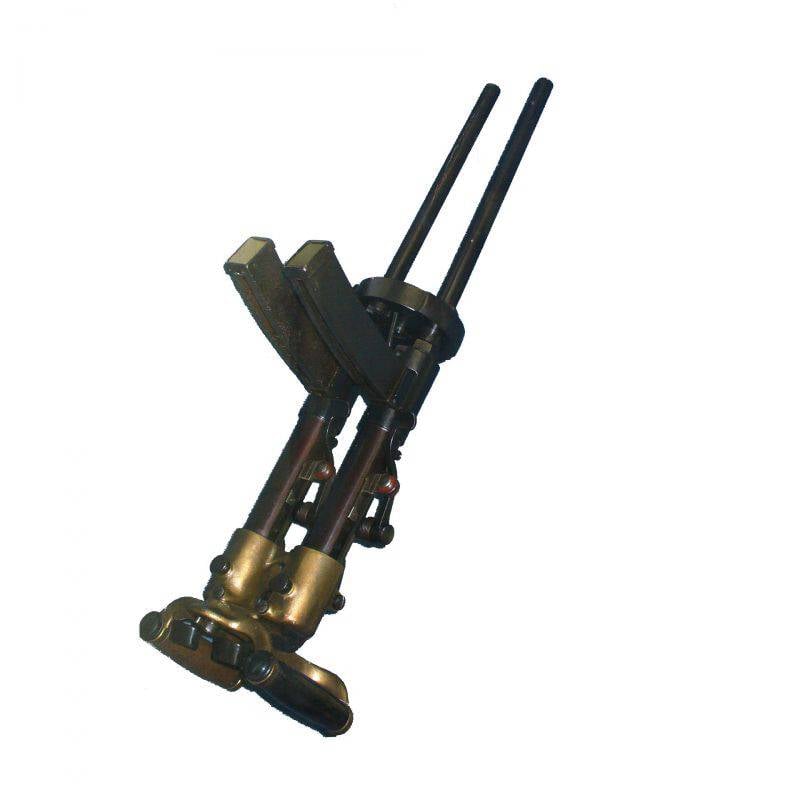
Information